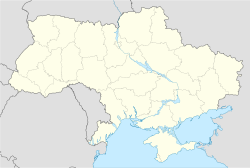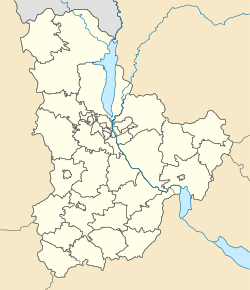- Chernobyl (city)
-
Chernobyl (Чернобыль)
Chornobyl (Чорнобиль)— Abandoned city — Coordinates: 51°23′23″N 30°5′59″E / 51.38972°N 30.09972°E Country  Ukraine
UkraineOblast  Kiev
KievRaion  Ivankiv (since 1986)
Ivankiv (since 1986)Government - Administration Zone of alienation Population (2010) - Total 500 Postal code 07270 Area code(s) +380 4493  Chernobyl area as seen from the Russian space station Mir in 1997 (51°22′50″N 30°06′59″E / 51.380567°N 30.116272°E)
Chernobyl area as seen from the Russian space station Mir in 1997 (51°22′50″N 30°06′59″E / 51.380567°N 30.116272°E)
Chernobyl (English pronunciation: /tʃərˈnəʊbɪl/; Russian: Чернобыль, pronounced [tɕɪrˈnobɨlʲ]) or Chornobyl (Ukrainian: Чорнобиль, pronounced [tʃɔrˈnɔbɪlʲ], Polish Czarnobyl) is an abandoned city in northern Ukraine, in Kiev Oblast, near the border with Belarus. The city had been the administrative centre of the Chernobyl Raion since 1932.
The city was evacuated in 1986 due to the Chernobyl disaster at the Chernobyl Nuclear Power Plant, located 14.5 kilometres (9.0 mi) north-northwest. The power plant was within Chernobyl Raion (District), but the city was not the residence of the power plant workers. When the power plant was under construction, Prypiat, a city larger and closer to the power plant, had been built as home for the power plant workers. After the accident the Chernobyl Raion administration was transferred to the neighboring Kiev Raion.
Though the city today is mostly uninhabited, a small number of people reside in houses marked with signs stating that the "Owner of this house lives here". Workers on watch and administrative personnel of the Zone of Alienation are stationed in the city on a long term basis. Prior to its evacuation, the city was inhabited by about 14,000 residents.[1] The city of Slavutych was built specifically for the evacuated population of Chernobyl.
Contents
Name origin
The city name is the same as a local Ukrainian name for Artemisia vulgaris (mugwort or common wormwood), which is also чорнобиль "chornobyl".[2] An alternative etymology holds that it is a combination of the words chornyi (чорний, black) and byllia (билля, grass blades or stalks), hence it would literally mean black grass or black stalks.
After the Chernobyl disaster, some[3] remarked upon partial similarities between the disaster and the tale of the 'star called Wormwood' in the Book of Revelation, which killed many people by making the water bitter.[3]
History
Chernobyl first appeared in a charter of 1193, described as a hunting-lodge of Knyaz Rostislavich.[4][5] It was a crown village of the Grand Duchy of Lithuania in the 13th century. The village was granted as a fiefdom to Filon Kmita, a captain of the royal cavalry, in 1566. The province containing Chernobyl was transferred to the Kingdom of Poland in 1569, and then annexed by the Russian Empire in 1793.[6] Prior to the 20th century, Chernobyl was inhabited by Ukrainian and some Polish peasants, and a relatively large number of Jews.
Chernobyl had a rich religious history. The Jews were brought by Filon Kmita, during the Polish campaign of colonization. The traditionally Christian Eastern Orthodox Ukrainian peasantry of the district was largely forced, by Poland, to convert to the Greek Catholic Uniate religion after 1596, and then forceably returned to Eastern Orthodoxy by the Tsar only after the Partitions of Poland. The Dominican church and monastery were founded in 1626 by Lukasz Sapieha, at the height of the Counter-reformation. There was a group of Old Catholics, who opposed the decrees of the Council of Trent. The Dominican monastery was sequestrated in 1832, following the failed Polish November Uprising, and the church of the Old Catholics was disbanded in 1852.[4]
In the second half of the 18th century, Chernobyl became one of the major centers of Hasidic Judaism. The Chernobyl Hasidic dynasty had been founded by Rabbi Menachem Nachum Twersky. The Jewish population suffered greatly from pogroms in October 1905 and in March–April 1919, when many Jews were killed and others were robbed, at the instigation of the Russian nationalist Black Hundreds. In 1920, the Twersky dynasty left Chernobyl, and it ceased to exist as a Hasidic centre.
Since the 1880s, Chernobyl has seen many changes of fortune. In 1898 Chernobyl had a population of 10,800, including 7,200 Jews. In World War I the village was occupied, and in the ensuing Civil War, Chernobyl was fought over by Bolsheviks and Ukrainians. In the Polish-Soviet War of 1919–20, it was taken first by the Polish Army and then by cavalry of the Red Army. From 1921, it was incorporated into the Ukrainian SSR.[4]
During the period 1929–33, Chernobyl suffered greatly from mass killings during Stalin's collectivization campaign, and in the Holodomor (famine) that followed. The Polish community of Chernobyl was deported to Kazakhstan in 1936 during the Frontier Clearances. The Jewish community was murdered during the German occupation of 1941–44.[4] Twenty years later, the area was chosen as the site of the first nuclear power station on Ukrainian soil.
The Duga-3 over-the-horizon radar array several miles out of Chernobyl was the origin of the infamous Russian Woodpecker, designed as part of Russia's anti-ballistic missile early warning radar network.
With the dissolution of the Soviet Union in 1991, Chernobyl remained part of Ukraine, now an independent nation.
However, in 2011 there continue to live a small number of people; those who refused to leave their native city after the Chernobyl Disaster of 1986.
Chernobyl nuclear reactor disaster
Main article: Chernobyl disasterOn April 26, 1986, Reactor #4 at the Chernobyl Nuclear Power Plant near the town of Pripyat, Ukraine, exploded. The explosion took place at 1:23am while the neighboring town of Pripyat slept. Two workers were killed instantly. 40 hours later, the residents of Pripyat were ordered to evacuate, and most never returned; by that time, many of the residents had suffered varying degrees of radiation poisoning.
In 2003, the United Nations Development Programme launched a project called the Chernobyl Recovery and Development Programme (CRDP) for the recovery of the affected areas.[7] The program launched its activities based on the Human Consequences of the Chernobyl Nuclear Accident report recommendations and was initiated in February 2002. The main goal of the CRDP's activities is supporting the Government of Ukraine to mitigate long-term social, economic and ecological consequences of the Chernobyl catastrophe, among others. CRDP works in the four most Chernobyl-affected areas in Ukraine: Kiev Oblast, Zhytomyrska Oblast, partially Kiev, Chernihivska Oblast and Rivne Oblast.
Chernobylite
Main article: ChernobyliteChernobylite is the name cited by two media sources[8][9] for highly radioactive, unusual and potentially novel crystalline formations found at the Chernobyl power-plant after the explosion. These formations were found in the basement below Reactor #4 during an investigation into missing reactor fuel.[10]
Notable persons
- Grigory Novak, Olympic medalist and world champion weightlifter
See also
References
- ^ Mould, Richard. "Evacuation zones and populations". Chernobyl Record. Bristol, England: Institute of Physics. p. 105. ISBN 0-7503-0670-X.
- ^ Gernot Katzer's Spice Pages, Mugwort (Artemisia vulgaris L.), by Gernot Katzer, 4 July 2006.
- ^ a b End Times Bible Prophecy Made Plain, by Tim McHyde.
www.theforbiddenknowledge.com Chernobyl, The Taste of Wormwood.
www.spiritoftruth.org Chernobyl Was Not An Accident, by J Adams, 26 April 2006. - ^ a b c d Norman Davies, Europe: A History, Oxford University Press, 1996, ISBN 0198201710
- ^ Chernobyl ancient history and maps.
- ^ Davies, Norman (1995) "Chernobyl", The Sarmatian Review, vol. 15, No. 1.
- ^ CRDP: Chernobyl Recovery and Development Programme (United Nations Development Program)
- ^ BBC Special Report: 1997: Containing Chernobyl?
- ^ Suicide Mission to Chernobyl: NOVA, Public Broadcasting Service (PBS)1991, 60mins
- ^ excerpt
External links
- Chernobyl today. Picture story
- United Nations Chernobyl Recovery and Development Programme See the actions of the Chernobyl Recovery and Development Programme towards Chernobyl-affected area and its population.
- The Flickr Chernobyl-Pripyat Group
- Chernobyl and Pripyat 22 years later
- EU To Extend Checks On Food From Chernobyl Area
- Chernobyl: Unlikely Tourist Spot - slideshow by Life magazine
- 25 years of satellite imagery over Chernobyl
Coordinates: 51°23′23″N 30°5′59″E / 51.38972°N 30.09972°E
Administrative divisions of Kiev Oblast, Ukraine Administrative center: Kiev Raions Baryshivka · Bila Tserkva · Bohuslav · Boryspil · Borodianka · Brovary · Fastiv · Ivankiv · Kaharlyk · Kiev-Sviatoshyn · Makariv · Myronivka · Obukhiv · Pereiaslav-Khmelnytskyi · Poliske · Rokytne · Skvyra · Stavysche · Tarascha · Tetiiv · Vasylkiv · Volodarka · Vyshhorod · Yahotyn · Zghurivka

Cities Urban-type
settlementsBaryshivka · Borodianka · Borova · Hostomel · Ivankiv · Kotsiubynske · Krasiatychi · Makariv · Rokytne · Stavysche · Volodarka · Zghurivka · moreVillages 1 Administratively separate from the surrounding Kiev Oblast. 2 Geographically located outside the borders of Kiev Oblast. Categories:- 1193 establishments
- Chernobyl disaster
- Chernobyl (Hasidic dynasty)
- Cities in Ukraine
- Jewish Polish history
- Jewish Russian and Soviet history
- Jewish Ukrainian history
- Kiev Oblast
- Shtetls
- Ghost towns in Ukraine
Wikimedia Foundation. 2010.



